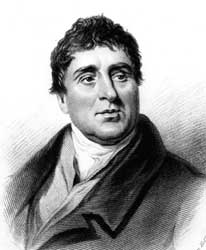 Initial
Involvement Initial
Involvement
Thomas Telford
first visited the canal construction works in 1817 in his capacity
as Consultant Engineer to the Exchequer Bill Loan Commissioners.
The Commissionersí remit was to promote public works which would
employ soldiers returning from the war with France that had ended
in 1815. Following Telford's visit, they agreed to support the project,
and construction work started again after a break of 19 years since
the initial phase in the 1790s.
Progress at a Price
Although
good progress was made, including a junction with the Stroudwater
Canal in 1820, the work of contractors and the supervision of resident
engineers fell short of what was required for such a huge project.
Telford was called in to advise on one crisis after another until
the available money was all spent with much work still to do at
Sharpness.
New Approach
After a
period of impasse, the Loan Commissioners took full financial control
of the project, and they accepted Telford's advice as to how construction
work should be managed in the future. Rather than seeking competitive
tenders, he recommended giving a detailed specification to one experienced
contractor, getting him to provide a detailed estimate and then
letting him work under the supervision of a reliable resident engineer.
On Telford's advice, Thomas Fletcher was recruited as resident engineer,
and after lengthy negotiations, a contract for completing the canal
was awarded to Hugh McIntosh in April 1823.
Contract Arrangements
The
contract set up by Telford and Fletcher at last provided a sound
basis for the engineering supervision and financial monitoring of
the huge project. The amount of work done each month was certified
by Fletcher, counter-signed by Telford and paid for by the Loan
Commissioners. Fletcher wrote regular reports to Telford and sometimes
sought his guidance. When it was realised that certain items of
additional work were needed to make the canal more useable, Telford
was involved in drawing up a second contract for McIntosh in March
1824. When there was concern that sand was accumulating between
the entrance piers at Sharpness, Telford gave instructions for reducing
the protrusion of the north-east pier and modifying the shape of
the other pier to encourage the currents to clear the sand.
Final Stage
Telford
was again involved in January 1825 when he backed the need for further
money to pay for additional mud clearing, accommodation for operating
staff and two warehouses at the north end of the basin at Gloucester.
His recommendation again ensured that the Loan Commissioners provided
the necessary finance. As work on the project continued, Telford
sent further reports to the Loan Commissioners, including one giving
his approval of its completion in April 1827, and then he authorised
the final accounts for McIntosh's contracts.
Conclusion
Although
Telford only visited the canal from time to time, it is clear that
he had a significant influence on certain design details and construction
methods during the latter stages of constructing the canal, but
probably of more significance was his role in obtaining the services
of a reliable resident engineer and a competent contractor and providing
them with sound contractual arrangements.
Sources
Telford correspondence
at the Ironbridge Gorge Museum and G&B Canal Co minute books
at the National Archives. |